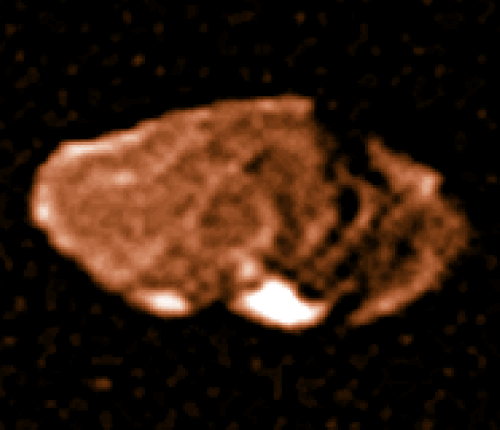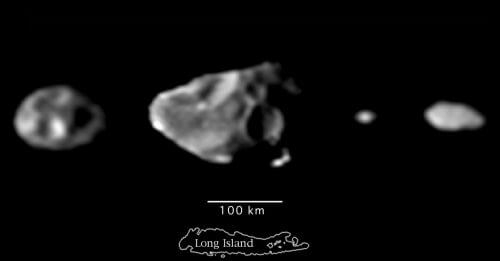On the moon Amalthea of the planet Jupiter, photographed by three different spacecraft - the two Voyager and Galileo spacecraft.

Amalthea is one of the moons of Jupiter. Until the launch of the Voyager spacecraft to Jupiter, all that was known about it was through telescopes. From the moment the Voyager spacecraft reached Jupiter, he was captured by their cameras, which transmitted his photographs to Israel. Additional photographs were taken by the Galileo spacecraft after it entered orbit around Jupiter. The total number of photographs that the three spacecraft transmitted from him was very few. From everywhere it turned out that this moon is an elongated body. Its length is 270 km and its maximum width is 160 km. Its color is reddish, something like an orange, and in one of the photos at the South Pole there is a particularly bright spot.
Its distance from Jupiter is 181,300 km and it orbits it once every 11 hours, almost as long as the time it takes for Jupiter to rotate around itself (about 10 hours), and it shows one side of it during the entire orbit. Its density is 0.85 grams per cubic meter, a little less than water and it is likely that it is porous and that it contains water. The Galileo spacecraft passed by it on February 5.2.2002, 160 at a distance of 90 km, but it was decided not to photograph it, which is a shame. It was possible to obtain high-resolution photographs and reveal many details from its surface. Instead it was decided to focus on his spectroscopic tests. Emtalea has large craters that are tens of kilometers in diameter. One crater, Pan, is 8 km in diameter and at least 75 km deep. Another Gaea crater has a diameter of 20 km and a depth of between 10 - 2.3 km. One third of the interior of the crater is 25 times brighter than the outside of the crater. Emtalea also has two reliefs - one of them Lycta Facula is 25 km long and rises to a height of 15 km. The Facula Ida relief is XNUMX km long.
In one of the photographs to the left of the moon there is a segment of a crater. The left section is missing. You can see that the missing section was splashed out of the magazine. The diameter of the full crater was tens of kilometers. It can be assumed that the length of the missing section was tens of kilometers.. The picture that is painted is the following. In the distant past, Amalthea circled Jupiter in a different orbit from the one that exists today. A large asteroid hit it and due to the force of the blow, part of the moon was torn off and blown away. Amalthea, from the force of the impact, was knocked out of its orbit, it began to move and entered another orbit around Jupiter until it stabilized. The part that was torn from it also entered orbit around Jupiter. It may be that in future flights to Jupiter, all the moons of Jupiter will be photographed, mapped, and by building a photo puzzle it will be possible to identify a small moon that was once a part of it.

מקור
https://en.wikipedia.org/wiki/Amalthea_(moon)

10 תגובות
Of all the possibilities you mentioned, the possibility that it will fall towards Jupiter is the most likely, given the size of Jupiter and its gravity, it is hard to believe that the torn part could have escaped it. The places you hypothesized he could go are too big for him to reach.
bastard
As you wrote: "The part that was torn from it, also entered orbit around Jupiter"" end of quote.. Why don't you have the confidence that the part that was torn off will still be found between one of the moons of Jupiter?, in my humble opinion there is a high chance that one of the following cases will happen to it: Pole to Jupiter, Pole to the Sun, To get lost in the space of the universe or even to become one of the satellites of justice found in the points of his Trojans or Greeks. It seems to me that the chance of it remaining as a small monthly of Tzedek is slim.
Kobi
I saw comments from different comments and I didn't fall off my chair..
Haim Mazar, I responded politely to your sarcastic-Israeli response (how Sharia expressed it). Maybe you'll finally talk to us in a calmer tone. In the end, other people can also react to you in a way that you would not like
lion
Tell the readers what the research goals of the Juno spacecraft are. Maybe we'll learn something new that we don't know.
A typical Israeli sarcastic response by a writer (Haim Mazar) to the commenter
Well, if you are sure (live) of what you say, I thank you for clarifying.. Sometimes the NASA staff can make new decisions, there is a certain flexibility in NASA projects - up to a certain limit of course
Where did you get this nonsense? The Juno spacecraft was only designed to study Jupiter.
Where did you get this nonsense? The Juno spacecraft was designed to study Jupiter.
Does anyone have any idea if the Juno probe is allowed - or even possible - to photograph Amalthea or other Jupiter moons?